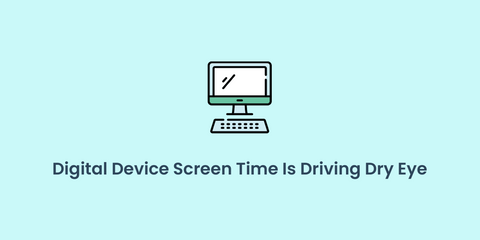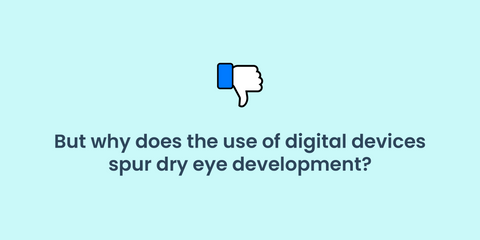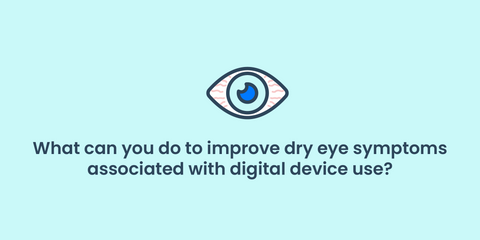We all know the feeling: tired, burning eyes after a long day glued to our digital screens. But did you know this isn't just a temporary annoyance? Staring at digital devices for hours can actually lead to dry eye, a condition that makes your eyes feel scratchy, uncomfortable, and even blurry.
Don't worry, you're not alone! In fact, millions of people struggle with dry eye, and the problem is only getting worse as our screen time skyrockets. But hey, there's good news! With a few simple changes, you can keep your eyes feeling fresh and comfortable even when you're glued to your phone or computer.
Ocular Surface diseases, such as meibomian gland dysfunction (MGD) and dry eye syndrome (DES), are on the rise in the United States. A recent study placed the incidence of full dry eye syndrome at 6.8% of the U.S. population, and studies regularly peg MGD at around 50-70% of the U.S. population. And for many, DES can be disruptive to their lives - preventing people from being outside, watching TV, or even just being present with their eyes open. In other words, DES can be incredibly uncomfortable.
One common behavior is helping to drive the incidence of these diseases - watching screens.

Americans continue to increase their screen time. From 2013 to 2022, screen time usage in the United States increased by 50 minutes - up to just over 7 hours of screen time per day. This screen time is split on average between streaming TV & video games (about 3 hours) and mobile phone usage (about 4 hours). This is not an American challenge, however. America’s screen time growth is consistent with growth around the world.
But why does the use of digital devices spur dry eye development?

First, when focusing on a screen, humans blink less frequently. According to an article published in Computers in Human Behavior, the mean blink rate of a resting person is about 22 blinks per minute. For a person focused on a screen, the rate shrinks to 7 blinks per minute (approximately ⅓ as frequent). This low blink rate contributes to a variety of tear related problems. According to the multiple studies, the lower blink rate leads to poorer tear quality (lower osmolarity). This means that the tear produced has the wrong consistency. This can mean that it coats the eye poorly, and it can mean that it dries off the eye too quickly. Either one leads to discomfort in many patients.
According to a recent study published by the NIH, use of a computer had a measurable negative impact on tear quality in individuals. Basically, the researchers measured quality of tears in the morning and then after extensive computer use. There were clear negative effects caused by computer use - likely the lower blink rate that has been credited in many papers including the one cited above.
Second, when a person blinks less frequently, they secrete fewer tears. This lower quantity of tears means that the glands are not working at their normal pace. According to Review of Ophthamology, a lower blink rate can cause the level of secretion to decrease. Over time, studies show that low blink rate can be correlated to degradation of meibomian glands. This degradation often means that the meibomian glands stop working properly. They can also atrophy or become clogged. Collectively, these glanular problems are called meibomian gland dysfunction.
What can be really tricky about MGD is many patients don’t have any discomfort at the onset of the disease. Instead, it often takes irreversible progression before symptoms start to manifest. Meaning your eyes are starting to produce fewer tears but you cannot feel the difference. When you can, it is often too late to reverse the loss.
What can you do to improve dry eye symptoms associated with digital device use?

1. Follow the 20-20-20 Rule
The 20-20-20 rule describes a practice for users of computers and other screens. Every 20 minutes, look into the distance about 20 feet, for 20 seconds. Some doctors also recommend rapidly blinking during the time looking away from the screen.
A corollary to the 20-20-20 Rule is to make sure that your computer or TV set up allows you to sit comfortably for a long period of time. Some of the back pain, headaches, etc. are actually caused by poor posture, not eye strain.
2. Better Eyelid Hygiene
The research on MGD and DES says virtually the same thing. Washing your eyelids every day and well is one way to avoid many long-term progressive eye related diseases. The literature primarily suggests a terpin-4-ol cleanser. But, there are multiple other products that have been shown to help alleviate symptoms, including okra oil and hypochlorous acid (HOCl). Check out this blog post on how to properly wash your eyelids.
3. An Omega-3 Vitamin
The research also suggests that regular use of an Omega-3 vitamin has positive effects on eye related tears and secretions. In multiple studies, Omega-3 vitamin users had lower incidence and lower effects of dry eye disease and other similar ocular surface diseases. We love these ProOmega Options recommended by optomotrists.
4. Short-Term Symptom Relief
If your eyes hurt right now, two consistently recommended short-term symptom relief tools are a warm compress. Generally, these are eye shaped “pillows” with special materials on the inside. They are heated up in the microwave. They provide short-term relief, and they can be used over time to help improve meibomian gland secretion. Second, many optometrists recommend an eye drop specifically targeting dry eye. Popular ones sold by Peeq Pro include Systane PF, Refresh Optive Advanced, and Optase Dry Eye Intense or MGD Advanced Drops.
Don't let dry eyes slow you down! Start incorporating these practices today and enjoy comfortable, healthy vision even in the digital age.

